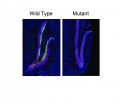(Press-News.org) For older adults, being unable to identify scents is a strong predictor of death within five years, according to a study published October 1, 2014, in the journal PLOS ONE. Thirty-nine percent of study subjects who failed a simple smelling test died during that period, compared to 19 percent of those with moderate smell loss and just 10 percent of those with a healthy sense of smell.
The hazards of smell loss were "strikingly robust," the researchers note, above and beyond most chronic diseases. Olfactory dysfunction was better at predicting mortality than a diagnosis of heart failure, cancer or lung disease. Only severe liver damage was a more powerful predictor of death. For those already at high risk, lacking a sense of smell more than doubled the probability of death.
"We think loss of the sense of smell is like the canary in the coal mine," said the study's lead author Jayant M. Pinto, MD, an associate professor of surgery at the University of Chicago who specializes in the genetics and treatment of olfactory and sinus disease. "It doesn't directly cause death, but it's a harbinger, an early warning that something has gone badly wrong, that damage has been done. Our findings could provide a useful clinical test, a quick and inexpensive way to identify patients most at risk."
The study was part of the National Social Life, Health and Aging Project (NSHAP), the first in-home study of social relationships and health in a large, nationally representative sample of men and women ages 57 to 85.
In the first wave of NSHAP, conducted in 2005-06, professional survey teams from the National Opinion Research Center at the University of Chicago used a well-validated test—adapted by Martha K. McClintock, PhD, the study's senior author—for this field survey of 3,005 participants. It measured their ability to identify five distinct common odors.
The modified smell tests used "Sniffin'Sticks," odor-dispensing devices that resemble a felt-tip pen but are loaded with aromas rather than ink. Subjects were asked to identify each smell, one at a time, from a set of four choices. The five odors, in order of increasing difficulty, were peppermint, fish, orange, rose and leather.
Measuring smell with this test, they learned that:
Almost 78 percent of those tested were classified as "normosmic," having normal smelling; 45.5 percent correctly identified five out of five odors and 29 percent identified four out of five.
Almost 20 percent were considered "hyposmic." They got two or three out of five correct.
The remaining 3.5 percent were labelled "anosmic." They could identify just one of the five scents (2.4%), or none (1.1%).
The interviewers also assessed participants' age, physical and mental health, social and financial resources, education, and alcohol or substance abuse through structured interviews, testing and questionnaires. As expected, performance on the scent test declined steadily with age; 64 percent of 57-year-olds correctly identified all five smells. That fell to 25 percent of 85-year-olds.
In the second wave, during 2010-11, the survey team carefully confirmed which participants were still alive. During that five-year gap, 430 (12.5%) of the original 3005 study subjects had died; 2,565 were still alive.
When the researchers adjusted for demographic variables such as age, gender, socioeconomic status (as measured by education or assets), overall health, and race, those with greater smell loss when first tested were substantially more likely to have died five years later. Even mild smell loss was associated with greater risk.
"This evolutionarily ancient special sense may signal a key mechanism that affects human longevity," noted McClintock, the David Lee Shillinglaw Distinguished Service Professor of Psychology, who has studied olfactory and pheromonal communication throughout her career.
Age-related smell loss can have a substantial impact on lifestyle and wellbeing, according to Pinto, a member of the university's otolaryngology-head and neck surgery team. "Smells impact how foods taste. Many people with smell deficits lose the joy of eating. They make poor food choices, get less nutrition. They can't tell when foods have spoiled or detect odors that signal danger, like a gas leak or smoke. They may not notice lapses in personal hygiene."
"Of all human senses," Pinto said, "smell is the most undervalued and underappreciated—until it's gone."
Precisely how smell loss contributes to mortality is unclear. "Obviously, people don't die just because their olfactory system is damaged," McClintock said.
The research team, which includes biopsychologists, physicians, sociologists and statisticians, is considering several hypotheses. The olfactory nerve, the only cranial nerve directly exposed to the environment, may serve as a conduit, they suggest, exposing the central nervous system to pollution, airborne toxins, pathogens or particulate matter.
McClintock noted that the olfactory system also has stem cells which self-regenerate, so "a decrease in the ability to smell may signal a decrease in the body's ability to rebuild key components that are declining with age and lead to all-cause mortality."
INFORMATION:
The study, "Olfactory Dysfunction Predicts 5-year Mortality in Older Adults," was funded by the National Institutes of Health—including the National Institute on Aging, the Office of Women's Health Research, the Office of AIDS Research, the Office of Behavioral and Social Sciences Research—and the McHugh Otolaryngology Research Fund, the American Geriatrics Society, and the Institute of Translational Medicine at the University of Chicago.
Additional authors were Kristen E. Wroblewski, David W. Kern, and L. Philip Schumm, all from the University of Chicago. Linda Waite is the principal investigator of NSHAP, a transdisciplinary effort with experts in sociology, geriatrics, psychology, epidemiology, statistics, survey methodology, medicine, and surgery collaborating to advance knowledge about aging. Such mining of the interface of disciplines is the classic paradigm of research at the University of Chicago.
Decreased ability to identify odors can predict death
Olfactory dysfunction is a harbinger of mortality
2014-10-01
ELSE PRESS RELEASES FROM THIS DATE:
AAO-HNSF clinical practice guideline: Tinnitus
2014-10-01
ALEXANDRIA, VA — The American Academy of Otolaryngology—Head and Neck Surgery Foundation has released the first ever mutli-disciplinary, evidence-based clinical practice guideline to improve the diagnosis and management of tinnitus, the perception of sound—often ringing—without an external sound source. The guideline was published today in the journal Otolaryngology–Head and Neck Surgery.
"Tinnitus affects 10-15% of adults in the United States. It is the most common service-related disability among our military veterans. Yet despite its prevalence and effect on quality ...
Decreased ability to identify odors may predict 5-year mortality
2014-10-01
For older adults, being unable to identify scents may be a predictor of mortality within five years, according to a study published October 1, 2014, in the journal PLOS ONE by Jayant Pinto from The University of Chicago and colleagues.
The study was part of the National Social Life, Health and Aging Project (NSHAP), the first in-home study of social relationships and health in a large, nationally representative sample of men and women ages 57 to 85. Researchers first surveyed 3,000 participants in 2005-06, assessing their ability to identify five distinct common odors, ...
Drug treats inherited form of intellectual disability in mice
2014-10-01
Studying mice with a genetic change similar to what is found in Kabuki syndrome, a inherited disease of humans, Johns Hopkins researchers report they have used an anticancer drug to "open up" DNA and improve mental function.
Along with a potential treatment for the intellectual disability seen in Kabuki syndrome, the study's findings also suggest a new way of thinking about a category of genetic diseases known as Mendelian disorders of the epigenetic machinery, the researchers say. In these disorders, a genetic mutation causes errors in the way proteins and chemicals ...
Study finds potential new target to treat asthma attacks brought on by colds
2014-10-01
Researchers have identified a molecular mechanism that could explain why the common cold can bring on life-threatening asthma attacks.
Published today in Science Translational Medicine, the findings indicate this may be a potential target for new drugs that could be more effective than existing treatments.
Viruses that infect the airways are the most common cause of asthma attacks, accounting for 80-90 per cent of cases. The great majority of these are rhinoviruses, which are the predominant cause of the common cold.
Although illnesses caused by rhinoviruses are ...
Stem cell discovery could lead to better treatments for blindness
2014-10-01
Scientists at the University of Southampton have discovered that a region on the front surface of the eye harbours special stem cells that could treat blinding eye conditions.
This part of the eye is called the 'corneal limbus' and is a narrow gap lying between the transparent cornea and white sclera.
The research, published in PLOS ONE, showed that stem cells can be cultured from the corneal limbus in vitro. Under the correct culture conditions, these cells could be directed to behave like the cells needed to see light - photoreceptor cells.
The loss of photoreceptors ...
Predictor of tissue injury in kidney transplant recipients found
2014-10-01
Researchers at UC San Francisco and Rush University Medical Center, Chicago, may have found a predictor for a disorder affecting kidney transplant recipients that can accelerate organ failure, a discovery that eventually could allow for customized therapies and improved patient selection for transplant.
The study of focal segmental glomerulosclerosis (FSGS), a devastating form of kidney disease, is in the Oct. 1 issue of Science Translational Medicine. Research was conducted by an international study team, with Necker Hospital in Paris and UCSF joint lead authors and ...
Researchers find promise in new treatments for GBM
2014-10-01
(Boston) — Glioblastma multiforme (GBM) is one of the most lethal primary brain tumors, with median survival for these patients only slightly over one year. Researchers at Boston University School of Medicine (BUSM), in collaboration with researchers from the City of Hope, are looking toward novel therapeutic strategies for the treatment of GBM in the form of targeted therapies against a unique receptor, the interleukin-13 receptor α chain variant 2 (IL13Rα2).
In a review paper published in the October issue of Neuro-Oncology, the researchers discuss various ...
Team advances understanding of the Greenland Ice Sheet's meltwater channels
2014-10-01
An international research team's field work, drilling and measuring melt rates and ice sheet movement in Greenland is showing that things are, in fact, more complicated than we thought.
"Although the Greenland Ice Sheet initially speeds up each summer in its slow-motion race to the sea, the network of meltwater channels beneath the sheet is not necessarily forming the slushy racetrack that had been previously considered," said Matthew Hoffman, a Los Alamos National Laboratory scientist on the project.
A high-profile paper appearing in Nature this week notes that observations ...
NASA sees intensifying typhoon Phanfone heading toward Japan
2014-10-01
VIDEO:
NASA's TRMM satellite saw Phanfone was producing rainfall over a very large area on Oct. 1. Some storms in these bands were dropping rain at a rate of over 76...
Click here for more information.
An intensifying typhoon called Phanfone that originated east of Guam on September 28, 2014 is headed toward southern Japan. The TRMM satellite crossed above Typhoon Phanfone on October 1, 2014 at 1039 UTC and gathered data about rainfall rates occurring in the storm.
TRMM, ...
Genetic secrets of the monarch butterfly revealed
2014-10-01
The monarch butterfly is one of the most iconic insects in the world, best known for its distinct orange and black wings and a spectacular annual mass migration across North America. However, little has been known about the genes that underlie these famous traits, even as the insect's storied migration appears to be in peril.
Sequencing the genomes of monarch butterflies from around the world, a team of scientists has now made surprising new insights into the monarch's genetics. They identified a single gene that appears central to migration – a behavior generally regarded ...
LAST 30 PRESS RELEASES:
Plant hormone allows lifelong control of proteins in living animal for first time
Swedish freshwater bacteria give new insights into bacterial evolution
Global measures consistently underestimate food insecurity; one in five who suffer from hunger may go uncounted
Hidden patterns of isolation and segregation found in all American cities
FDA drug trials exclude a widening slice of Americans
Sea reptile’s tooth shows that mosasaurs could live in freshwater
Pure bred: New stem cell medium only has canine components
Largest study of its kind highlights benefits – and risks – of plant-based diets in children
Synergistic effects of single-crystal HfB2 nanorods: Simultaneous enhancement of mechanical properties and ablation resistance
Mysterious X-ray variability of the strongly magnetized neutron star NGC 7793 P13
The key to increasing patients’ advance care medical planning may be automatic patient outreach
Palaeontology: Ancient tooth suggests ocean predator could hunt in rivers
Polar bears may be adapting to survive warmer climates, says study
Canadian wildfire smoke worsened pediatric asthma in US Northeast: UVM study
New UBCO research challenges traditional teen suicide prevention models
Diversity language in US medical research agency grants declined 25% since 2024
Concern over growing use of AI chatbots to stave off loneliness
Biomedical authors often call a reference “recent” — even when it is decades old, analysis shows
The Lancet: New single dose oral treatment for gonorrhoea effectively combats drug-resistant infections, trial finds
Proton therapy shows survival benefit in Phase III trial for patients with head and neck cancers
Blood test reveals prognosis after cardiac arrest
UBCO study finds microdosing can temporarily improve mood, creativity
An ECOG-ACRIN imaging study solves a long-standing gap in metastatic breast cancer research and care: accurately measuring treatment response in patients with bone metastases
Cleveland Clinic presents final results of phase 1 clinical trial of preventive breast cancer vaccine study
Nationally renowned anesthesiology physician-scientist and clinical operations leader David Mintz, MD, PhD, named Chair of the Department of Anesthesiology at the UM School of Medicine
Clean water access improves child health in Mozambique, study shows
Study implicates enzyme in neurodegenerative conditions
Tufts professor named Fellow of the National Academy of Inventors
Tiny new device could enable giant future quantum computers
Tracing a path through photosynthesis to food security
[Press-News.org] Decreased ability to identify odors can predict deathOlfactory dysfunction is a harbinger of mortality




